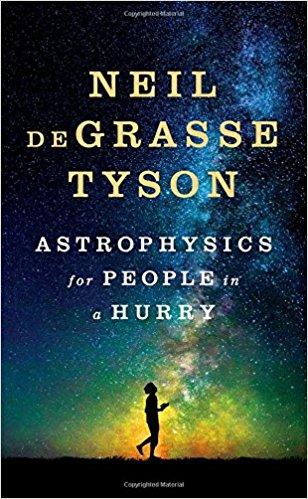Astrophysics for People in a Hurry Summary
7 min read ⌚
 Are you in a hurry?
Are you in a hurry?
Do you, nevertheless, want to know something more about the universe you live in?
Well, then it’s time for few lessons in astrophysics by none other than Mr. Neil deGrasse Tyson.
Ladies and gentlemen, presenting you the summary for –
“Astrophysics for People in a Hurry.”
Who Should Read “Astrophysics for People in a Hurry”? And Why?
Carl Sagan – the man who made many people fall in love with science in the 1980s – had a habit of saying that astrophysics is the science of humility – in addition to science itself being a character-building endeavor.
Sagan’s widely beloved successor Neil deGrasse Tyson believes in these very same things.
And he shares Sagan’s exceptional capacity of making this clear via illustrative simplification of many seriously complex and even counter-intuitive scientific concepts.
Which is why “Astrophysics for People in a Hurry” is not only a book about people who don’t have enough time to learn more about the universe but want to.
It’s also about those who have time but don’t want to.
In fact, if you ask us, it is especially about the latter.
 About Neil DeGrasse Tyson
About Neil DeGrasse Tyson
Neil deGrasse Tyson is an American astrophysicist, popularizer of science, and, since 1996, the Frederick P. Rose Director of the Hayden Planetarium, fully reconstructed during his tenure.
An author of numerous essays and books – “Death by Black Hole” being the most famous one up to “Astrophysics for People in a Hurry” – Tyson is probably best recognized as the host of “Cosmos: A Spacetime Odyssey,” the sequel to Carl Sagan’s ultra-popular 1980 series “Cosmos: A Personal Voyage”
Tyson has received numerous awards, including NASA’s Distinguished Public Service Medal in 2004 and the Public Welfare Medal awarded to Tyson by the National Academy of Sciences in 2015 for his “extraordinary role in exciting the public about the wonders of science.”
“Astrophysics for People in a Hurry PDF Summary”
It’s quite difficult to summarize a book such as “Astrophysics for People in a Hurry.”
Not only because the subjects it deals with are grand on any scale – the creation of the universe, its structure, dark matter, dark energy, etc. – but also because Tyson presents them in a way which makes the presentation dependent on both his style and his analogies.
Once you conceptualized these, you’ll never forget what they are, in fact, standing for and explaining.
As he explains in the preface, that’s Tyson’s very goal: to make you “culturally conversant in [his] field of expertise.”
And, as you can see for yourself in this video, he is quite good at doing that:
https://www.youtube.com/watch?v=MtkQpR0acAQ
Now, we have only about 1,000 words to recount you briefly the history of nearly everything and, of course, we are going to need to rush through Tyson’s presentation.
Which starts where it all started – including time itself.
The Big Bang.
About 13.8 billion years ago, when the universe started expanding from a very high-temperature and high-density state, creating space, time, physical laws and everything else.
Speaking of physical laws – let’s get one thing straight.
Tyson is quite adamant in insisting that most of the things he talks about are undeniably true. “The power and beauty of physical laws,” he writes, “is that they apply everywhere, whether or not you choose to believe in them. In other words, after the laws of physics, everything else is opinion.”
So, it’s a fact that the Earth didn’t exist for the first two-thirds of the time the Universe has existed and that it was first formed about 4.5 billion years ago.
Even more interesting, it took billions of years for the earliest plants to appear on the planet and almost a billion more for the earliest apes.
In other words, homo sapiens has been around for no more than, say, 300,000 years, which means only about 0.006% of the time the Earth is around.
And that’s where things get even more interesting: during this time, humanity – basically “stardust brought to life” – has discovered numerous physical laws and has devised hundreds of theories to explain their origin and meaning.
So, it’s basically as if the universe is learning about its beginnings through us!
While explaining Einstein’s prediction of gravitational waves and the importance of their first ever detection in 2015, Tyson beautifully summarizes this full circle.
Namely, when the now-detected gravitational waves were generated (by a collision of black holes in a galaxy 1.3 billion light-years away), there were only single-celled organisms on this planet.
And while these gravitational waves were traveling, the Earth would manage to “evolve complex life, including flowers and dinosaurs and flying creatures, as well as a branch of vertebrates called mammals.”
The primates branched out of these mammals, and then – in the last 10,000 years – “a single branch of these primates would develop a genetic mutation that allowed speech, and that branch – Homo Sapiens – would invent agriculture and civilization and philosophy and art and science.”
Then came Einstein and he devised the theory of relativity which predicted the existence of these gravitational waves.
A century later, people developed technology powerful enough to see these waves, and humanity “would finally catch up with the prediction, just days before that gravity wave, which had been traveling for 1.3 billion years, washed over Earth and was detected.”
Now, that’s beautiful!
But, as deGrasse Tyson, demonstrates: it’s merely the beginning.
Since as much as we know – or, as in this case, have probably predicted well enough about the universe – there’s much more that we don’t know.
Take dark matter and dark energy, for example!
They make up most of our universe, and, still, we know nothing about them except for the fact that they exist.
It’s basically as if we know nothing about water.
So, there’s still plenty to learn.
And all of it promises to be a magnificent adventure!
Key Lessons from “Astrophysics for People in a Hurry”
1. You Drink the Water Genghis Khan Once Drank
2. Isaac Newton Robbed God of His Job
3. The Cosmic Perspective
You Drink the Water Genghis Khan Once Drank
We mentioned water at the end of our summary.
Here’s an interesting fact about that all-important substance:
Every cup that passes through a single person and eventually rejoins the world’s water supply holds enough molecules to mix 1,500 of them into every other cup of water in the world. No way around it: some of the water you just drank passed through the kidneys of Socrates, Genghis Khan, and Joan of Arc.
Wow!
Or, maybe, ugh?
Isaac Newton Robbed God of His Job
Even after it was conclusively proven that the Earth is not the center of the Universe, philosophers still believed in some divine presence, because some of the planets’ motions were inexplicable.
Then Isaac Newton came, and he rendered all motion comprehensible and predictable.
What should the Creator do now? – asked the theologians. And if there’s nothing he should do, doesn’t that mean that he might as well not exist?
DeGrasse Tyson – and many other astrophysicists – don’t think that these are difficult questions.
According to them, the facts prove conclusively: even if God does exist, he has absolutely no explanatory value.
The Cosmic Perspective
If you ask us, the most important chapter of this whole book – the culmination to which all other chapters build to – is the last one, “Reflections on the Cosmic Perspective.”
What it all boils down to?
First of all, that “the universe is under no obligation to make sense to you.”
And secondly, that the Earth is a nothing more than a mote. But “it’s a precious mote and, for the moment, it’s the only home we have.”
How important is this revelation, this cosmic perspective of our existence?
Well, let’s see what Tyson has to say on the subject:
Now imagine a world in which everyone, but especially people with power and influence, holds an expanded view of our place in the cosmos. With that perspective, our problems would shrink—or never arise at all—and we could celebrate our earthly differences while shunning the behavior of our predecessors who slaughtered each other because of them.
Like this summary? We’d like to invite you to download our free 12 min app, for more amazing summaries and audiobooks.
“Astrophysics for People in a Hurry Quotes”
The universe is under no obligation to make sense to you. Share on X
We are stardust brought to life, then empowered by the universe to figure itself out—and we have only just begun. Share on X
The power and beauty of physical laws is that they apply everywhere, whether or not you choose to believe in them. In other words, after the laws of physics, everything else is opinion. Share on X
We do not simply live in this universe. The universe lives within us. Share on X
People who believe they are ignorant of nothing have neither looked for, nor stumbled upon, the boundary between what is known and unknown in the universe. Share on X
Our Critical Review
“Astrophysics for People in a Hurry” is mostly a collection of Tyson’s “Natural History” essays published during the decade between 1997 and 2007.
Because of this, most of it may be familiar to fans of Tyson’s work.
Even so, none of it should be boring to anyone: exceptionally well written, full of Tyson’s recognizable wit and even more recognizable analogies, “Astrophysics for People in a Hurry” is both an accessible and illuminating work.
So – as “BBC Sky at Night” advises – don’t rush through it.
Take your time and savor each chapter.
This book can radically alter your opinion about, well, everything.
Emir is the Head of Marketing at 12min. In his spare time, he loves to meditate and play soccer.


 About Neil DeGrasse Tyson
About Neil DeGrasse Tyson




